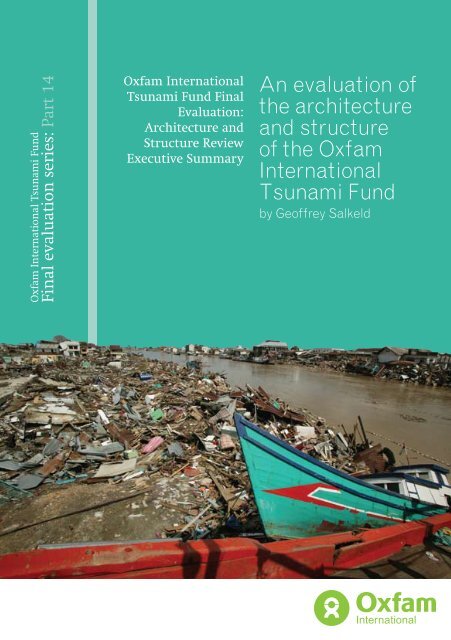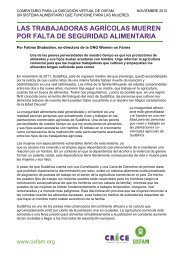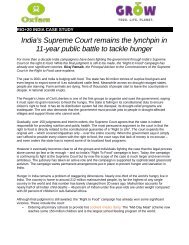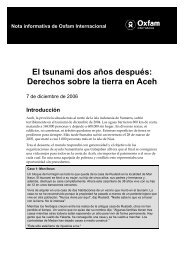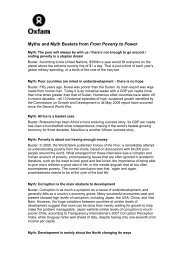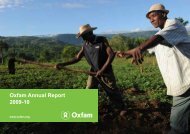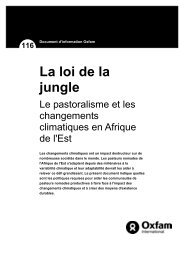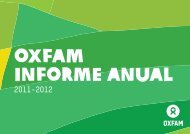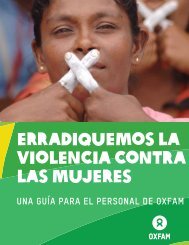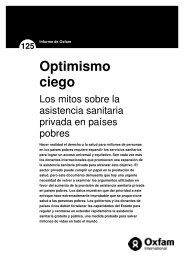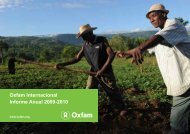Architect. summary report - Oxfam International
Architect. summary report - Oxfam International
Architect. summary report - Oxfam International
You also want an ePaper? Increase the reach of your titles
YUMPU automatically turns print PDFs into web optimized ePapers that Google loves.
<strong>Oxfam</strong> <strong>International</strong> Tsunami Fund<br />
Final evaluation series: Part 14<br />
<strong>Oxfam</strong> <strong>International</strong><br />
Tsunami Fund Final<br />
Evaluation:<br />
<strong>Architect</strong>ure and<br />
Structure Review<br />
Executive Summary<br />
An evaluation of<br />
the architecture<br />
and structure<br />
of the <strong>Oxfam</strong><br />
<strong>International</strong><br />
Tsunami Fund<br />
by Geoffrey Salkeld
Tsunami Evaluation series<br />
As part of its ongoing aims to learn from experience and to hold itself<br />
accountable for its actions, <strong>Oxfam</strong> has commissioned a wide-ranging<br />
evaluation of its response to the Indian Ocean tsunami of 2004. This<br />
comprises 14 thematic evaluations, 12 of the 14 studies have been<br />
conducted by independent consultants, while the remaining two<br />
conducted by members of <strong>Oxfam</strong> <strong>International</strong> Tsunami<br />
Fund secretariat (*)<br />
Recurring issues and key themes from the 14 individual evaluations are<br />
brought together in this evaluation <strong>summary</strong> <strong>report</strong> ’In the Wake of<br />
the Tsunami’.<br />
The <strong>report</strong>s available in this series are:<br />
Evaluation <strong>summary</strong> <strong>report</strong>: ’In the Wake of the Tsunami’<br />
Thematic evaluations:<br />
1. Livelihoods Review (Rajan Alexander)<br />
2. Public Health Review (Pradeep Bharwad & Wim Klassen)<br />
3. Shelter Review (Sarbjit Singh Sahota & Dave Hodgkins)<br />
4. Gender Review (Annette Salkeld)<br />
5. Downward Accountability Review (Ravinder Kumar &<br />
N. Raghunathan, Catalyst Management Services)<br />
6. Corporate Accountability Review (John Chilver*)<br />
7. Advocacy Review (Alasdhair Collins)<br />
8. Disaster Risk Reduction Review (Man B. Thapa)<br />
9. Partners and Partnerships Review (Stuart Kenward)<br />
10. Monitoring and Evaluation Programme Review (Catherine Lowery)<br />
11. Communications Review (Alex Wynter)<br />
12. Funding and Finance Review (Clive Surman & John Chilver*)<br />
13. Management Issues Review (Simon Harris)<br />
14. OITF <strong>Architect</strong>ure and Structure Review (Geoffrey Salkeld)<br />
The evaluation <strong>summary</strong> <strong>report</strong> and the executive summaries for the<br />
individual reviews can be found on the <strong>Oxfam</strong> website at<br />
www.oxfam.org/emergencies/tsunami. Full versions of the individual<br />
reviews are available on request from the <strong>Oxfam</strong> <strong>International</strong><br />
Secretariat via www.oxfam.org/contact.<br />
Philip Horgan,<br />
<strong>Oxfam</strong> <strong>International</strong> Tsunami Fund Monitoring and Evaluation<br />
Coordinator, December 2009<br />
Cover image: Almost the whole of the Banda Aceh fishing fleet was destroyed<br />
as the tsunami rushed up the river into the city, carrying with it most of the<br />
anchored trawlers and crushing them against the first bridge. Only boats that<br />
were out at sea survived. Credit: Jim Holmes/<strong>Oxfam</strong><br />
Background<br />
In response to the 2004 Indian Ocean tsunami, <strong>Oxfam</strong> <strong>International</strong><br />
established a new charity; the <strong>Oxfam</strong> <strong>International</strong> Tsunami<br />
Fund, with associated new bodies and structures as well as further<br />
developing existing organisational structures for humanitarian<br />
response. This evaluation review the merits of those bodies<br />
and structures.<br />
Executive <strong>summary</strong><br />
Introduction<br />
1. This survey was conducted during November/December<br />
2008. Sixty people were invited to complete a web-based<br />
questionnaire: by 16 December, 35 (58 per cent) had<br />
responded and 31 had completed the survey. Six individuals<br />
with particular responsibilities were asked specific questions<br />
by e-mail and/or telephone (three responded). Background<br />
documents provided by the Tsunami M&E Co-ordinator<br />
were reviewed.<br />
2. This <strong>report</strong> reviews:<br />
• Responses to the main questionnaire<br />
• Contributions from individual respondents<br />
• The issues raised in the documents<br />
• Implications and issues for the future.<br />
Context: the architecture i<br />
3. <strong>Oxfam</strong> ii created the Tsunami Fund, Tsunami Fund<br />
Management Team, and Audit Committee to meet the<br />
practical and humanitarian challenges of a devastating, multicountry<br />
emergency and the accountability challenge of an<br />
overwhelmingly generous public response. However, these<br />
should also be seen in the context of the evolution of <strong>Oxfam</strong>’s<br />
structures for responding to humanitarian emergencies.<br />
1
The perceived need for the Tsunami Fund as a separate legal<br />
entity reflects the view that <strong>Oxfam</strong> had not yet established a<br />
system for transferring funds speedily, efficiently, and fairly<br />
between affiliates. When the tsunami made such a system<br />
necessary, the Fund (and Audit Committee) were created to fill<br />
the gap. However, the TFMT evolved out of the Humanitarian<br />
Consortium and the HC Management Group, and derived<br />
experience and credibility from these bodies. Humanitarian<br />
Country Teams, which provided the third pillar of the tsunami<br />
architecture, were already in existence, though new and<br />
inexperienced. The architecture was therefore partly new,<br />
partly an adaptation, and partly a continuation of an<br />
existing structure.<br />
Appreciation of the quality<br />
of <strong>Oxfam</strong>’s response<br />
4. The majority of respondents to the main questionnaire<br />
thought that the quality of <strong>Oxfam</strong>’s tsunami response was<br />
up to or exceeded the standard they expected from <strong>Oxfam</strong>,<br />
throughout the response. The majority of respondents thought<br />
that the architecture had a positive impact on the quality of<br />
<strong>Oxfam</strong>’s response.<br />
Appreciation of the architecture<br />
5. The impact and value of the architecture were not seen<br />
as very significant during the initial phase of the response.<br />
Appreciation grew during the middle and later phases.<br />
However, during the later phase ‘fatigue’ was <strong>report</strong>ed, as<br />
structures and procedures that had necessarily been put<br />
together at speed were still in place two or three years later<br />
and under considerable strain.<br />
6. On the whole, ‘upstream’ respondents (such as TF Board and<br />
TFMT members and staff) are more positive about the value of<br />
the architecture than those closer to the action (such as fieldbased<br />
HCT members). However, there are exceptions at both<br />
ends of the spectrum.<br />
7. Views differ about the need for and value of the Tsunami<br />
Fund as a separate UK-registered charity. Some respondents<br />
close to the TF question whether it was actually necessary<br />
and suggest that the Executive Directors and existing interaffiliate<br />
contractual arrangements could have handled the<br />
responsibility that was given to the Fund Board. The Audit<br />
Committee is seen by respondents who mention it as a<br />
necessary body for ensuring high standards of accountability.<br />
8. There is general agreement on the need for and value of<br />
the Tsunami Fund Management Team. No respondent has<br />
suggested any alternative means of ‘virtual’ fund management,<br />
allocation, and ensuring accountability. Respondents’<br />
criticisms of the TFMT are primarily about specific instances of<br />
its performance rather than about the need for such a body.<br />
9. There is general agreement that Humanitarian Country Teams<br />
were an essential component of the architecture but that their<br />
capacities need to be strengthened. The concept was new<br />
and had to be put into practice during the response. Their<br />
performance was far too vulnerable to affiliate ‘turf’ competition<br />
and dependent on the qualities of individuals rather than<br />
robust systems. Respondents from each of the HCTs express<br />
divergent views about their team’s performance, some very<br />
positive, others critical.<br />
10. Responses to the question about the impact of the<br />
architecture on relations with and support for local partners<br />
indicate that arguments continue about the merits of working<br />
with partners versus direct implementation. Top-level OI efforts<br />
to break through the impasse need to be communicated<br />
convincingly throughout the confederation and especially<br />
among programme staff.<br />
2 3
Other lessons and<br />
implications for the future<br />
11. There is general agreement that if a comparable<br />
(i.e. exceptional) emergency and similar public response<br />
occurred again, extraordinary arrangements would be needed<br />
and that some elements of the tsunami architecture should<br />
be adapted. Several respondents emphasise the need for<br />
readiness, i.e. a robust ‘super-emergency’ stand-by plan,<br />
ready to be put into action. The TFMT model and (greatly<br />
strengthened) HCTs should form the core of such a plan.<br />
However, opinions are divided about the need for establishing<br />
a separate entity such as the Tsunami Fund. It could be seen<br />
as having filled gaps which should not have existed.<br />
12. The adoption of the ‘Governance Framework for Managing<br />
Exceptional Emergencies’ makes it clear that an ‘Exceptional<br />
Emergency Management Committee’ would have a remit and<br />
composition similar to that of the TFMT, and presumably this<br />
Framework would be capable of absorbing the lessons of the<br />
TFMT’s experience in handling an ‘exceptional’ emergency.<br />
13. However, there is less clarity around carrying the learning<br />
about the tsunami architecture forward to contingency<br />
planning about future Category 1 (and 2) emergencies.<br />
This is because of two recent policy decisions: the ‘step<br />
aside’ decision by which <strong>Oxfam</strong> GB is the default lead for<br />
all Category 1 emergencies and the ‘single management<br />
structure’ policy decision. Working through the implications of<br />
these decis ions should take account of the lessons emerging<br />
from this and the other reviews forming the Tsunami Final<br />
Evaluation. As Category 1 and 2 emergencies are more<br />
frequent and numerous than ‘exceptional’ emergencies, these<br />
issues need addressing urgently.<br />
14. The HCTs (perhaps with regional-level backstopping) should<br />
be the starting point for reforming the architecture of future<br />
humanitarian response, rather than further elaboration of the<br />
global-level structure.<br />
References<br />
i<br />
The ‘architecture’ refers to the Tsunami Fund, governed by the Tsunami Fund<br />
Board (referred to in the <strong>report</strong> as the TF), the Tsunami Fund Management<br />
Team (TFMT), and Humanitarian Country Teams (HCTs).<br />
ii<br />
Throughout the <strong>report</strong>, the term ‘<strong>Oxfam</strong>’ is used to mean the <strong>Oxfam</strong><br />
<strong>International</strong> confederation, and individual affiliates and OI structures are<br />
referred to by name.<br />
4 5
<strong>Oxfam</strong> <strong>International</strong> is a confederation of fourteen organizations working together in more<br />
than 100 countries to find lasting solutions to poverty and injustice: <strong>Oxfam</strong> America, <strong>Oxfam</strong><br />
Australia, <strong>Oxfam</strong>-in-Belgium, <strong>Oxfam</strong> Canada, <strong>Oxfam</strong> France - Agir ici, <strong>Oxfam</strong> Germany, <strong>Oxfam</strong><br />
GB, <strong>Oxfam</strong> Hong Kong, Intermón <strong>Oxfam</strong> (Spain), <strong>Oxfam</strong> Ireland, <strong>Oxfam</strong> Mexico, <strong>Oxfam</strong> New<br />
Zealand, <strong>Oxfam</strong> Novib (Netherlands), and <strong>Oxfam</strong> Québec. Please call or write to any of the<br />
agencies for further information, or visit www.oxfam.org<br />
<strong>Oxfam</strong> America: www.oxfamamerica.org<br />
<strong>Oxfam</strong> Australia: www.oxfam.org.au<br />
<strong>Oxfam</strong>-in-Belgium: www.oxfamsol.be<br />
<strong>Oxfam</strong> Canada: www.oxfam.ca<br />
<strong>Oxfam</strong> France - Agir ici: www.oxfamfrance.org<br />
<strong>Oxfam</strong> Germany: www.oxfam.de<br />
<strong>Oxfam</strong> GB: www.oxfam.org.uk<br />
<strong>Oxfam</strong> Hong Kong: www.oxfam.org.hk<br />
Intermón <strong>Oxfam</strong> (Spain): www.intermonoxfam.org<br />
<strong>Oxfam</strong> Ireland: www.oxfamireland.org<br />
<strong>Oxfam</strong> Mexico: web: www.oxfammexico.org<br />
<strong>Oxfam</strong> New Zealand: www.oxfam.org.nz<br />
<strong>Oxfam</strong> Novib (Netherlands): www.oxfamnovib.nl<br />
<strong>Oxfam</strong> Québec: www.oxfam.qc.ca<br />
<strong>Oxfam</strong> <strong>International</strong> Secretariat: Suite 20, 266 Banbury Road, Oxford, OX2 7DL, UK<br />
Tel: +44 1865 339100 Email: information@oxfaminternational.org<br />
Web site: www.oxfam.org<br />
For contact details of <strong>Oxfam</strong> <strong>International</strong> advocacy offices, please see the website of <strong>Oxfam</strong><br />
<strong>International</strong> Secretariat, or: E-mail: advocacy@oxfaminternational.org<br />
Linked <strong>Oxfam</strong> organization.<br />
<strong>Oxfam</strong> <strong>International</strong> and Ucodep Campaign Office (Italy)<br />
Email: ucodep-oi@oxfaminternational.org<br />
<strong>Oxfam</strong> observer members<br />
The following organizations are currently observer members of <strong>Oxfam</strong> <strong>International</strong>, working<br />
towards possible full affiliation:<br />
<strong>Oxfam</strong> Japan: www.oxfam.jp<br />
<strong>Oxfam</strong> India: www.oxfamindia.org<br />
<strong>Oxfam</strong> <strong>International</strong> Tsunami Fund is a limited company number 5401107 registered in England and Wales<br />
and a registered charity number 1108700. The registered office is Suite 20, 266 Banbury Road, Oxford<br />
OX2 7DL, United Kingdom.<br />
<strong>International</strong>


